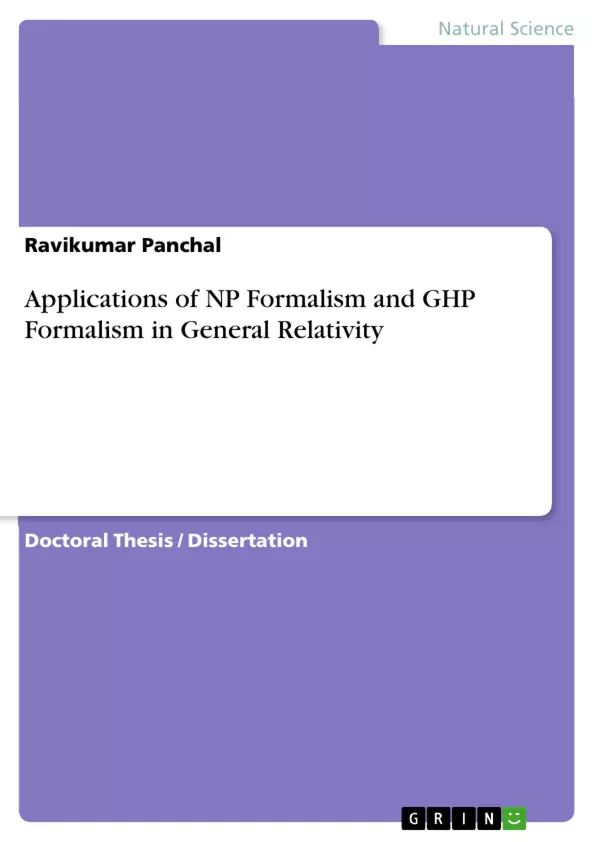Einstein proposed general relativity theory in 1915, this theory most successfully describes gravity. A typical approach to analyze gravitational field of an object is to solve Einstein’s field equations, in this approach the assumptions are guided by observations and they help in understanding physical aspects. From mathematical stand point of view we may look for geometric tools. In recent times, tetrad formalisms like Newman-Penrose formalism and Geroch-Held-Penrose formalism are popular to analyze gravitational field. Tetrad formalisms are based on choosing a suitable set of basis vectors for the spacetime under consideration. For using a tetrad formalism the relevant quantities are projected on to the chosen basis and the equations satisfied by them are considered. In this thesis, we have developed some applications of the NP formalism and GHP formalism to electromagnetic gravitational analogies, (i) electric and magnetic parts of the Weyl tensor and (ii) Lanczos potential. The complication involved in the computations compelled us to pay some attention to work in computer aided algebraic computations.
Inhaltsverzeichnis (Table of Contents)
- Chapter 1: Introduction
- General Relativity and its Tensors
- Electromagnetism and Gravity Analogies
- Introduction to Tetrad Formalisms
- Chapter 2: Computer Algebra System (CAS) Mathematica in General Relativity
- Algebraic Computations in General Relativity
- Mathematica Programs for Computations
- Chapter 3: Electric and Magnetic Parts of the Weyl Tensor
- Expressions in Terms of Spin Coefficients
- Time Efficient Algorithm for Computation
- Proof of Geometric Theorems
- Chapter 4: Lanczos Potential for Non-Vacuum Spacetimes
- Application of NP Formalism
- Vaidya Metric
- Van Stockum Spacetime
- Chapter 5: Solving Weyl-Lanczos Relations using GHP Formalism
- Gödel Spacetime
- Generalized pp-waves Spacetime
- Van Stockum Spacetime
Zielsetzung und Themenschwerpunkte (Objectives and Key Themes)
The thesis explores the application of the Newman-Penrose (NP) formalism and Geroch-Held-Penrose (GHP) formalism in general relativity, focusing on electromagnetic gravitational analogies. The main objective is to develop and demonstrate practical applications of these formalisms in solving specific problems related to the Weyl tensor and Lanczos potential. The study emphasizes computer-aided algebraic computations to handle the complex calculations involved.
- Applications of NP and GHP formalisms in general relativity
- Electromagnetic-gravitational analogies: electric and magnetic parts of the Weyl tensor and Lanczos potential
- Development of efficient algorithms for algebraic computations using computer algebra systems
- Solutions of Weyl-Lanczos relations for specific non-vacuum spacetimes
- Comparative analysis of NP and GHP methods for solving specific problems in general relativity
Zusammenfassung der Kapitel (Chapter Summaries)
Chapter 1 provides a foundational introduction to general relativity, focusing on fundamental tensors and their roles. It introduces the two key analogies between electromagnetism and gravity that are explored throughout the thesis: the electric and magnetic parts of the Weyl tensor and the Lanczos potential. The chapter also introduces tetrad formalisms, which are crucial tools for analyzing gravitational fields in the later chapters.
Chapter 2 delves into the application of computer algebra systems (CAS) for algebraic computations in general relativity. It highlights the need for efficient tools to manage the complex calculations involved. The chapter details the development of Mathematica programs designed to facilitate these computations.
Chapter 3 presents a method for expressing the electric and magnetic parts of the Weyl tensor in terms of spin coefficients. This method leads to a time-efficient algorithm for calculating these quantities, which is validated through the verification of known theorems related to specific geometric quantities.
Chapter 4 showcases the application of the NP formalism to obtain the Lanczos potential for non-vacuum spacetimes, namely the Vaidya metric and the Van Stockum spacetime. This exploration suggests the potential for applying this method to other non-vacuum and/or non-Petrov type spacetimes.
Schlüsselwörter (Keywords)
General relativity, NP formalism, GHP formalism, Weyl tensor, Lanczos potential, electromagnetic-gravitational analogies, non-vacuum spacetimes, computer algebra systems (CAS), Mathematica, spin coefficients, algebraic computations, Vaidya metric, Van Stockum spacetime, Gödel spacetime, generalized pp-waves spacetime.
- Arbeit zitieren
- Ravikumar Panchal (Autor:in), 2017, Applications of NP Formalism and GHP Formalism in General Relativity, München, GRIN Verlag, https://www.grin.com/document/380796



